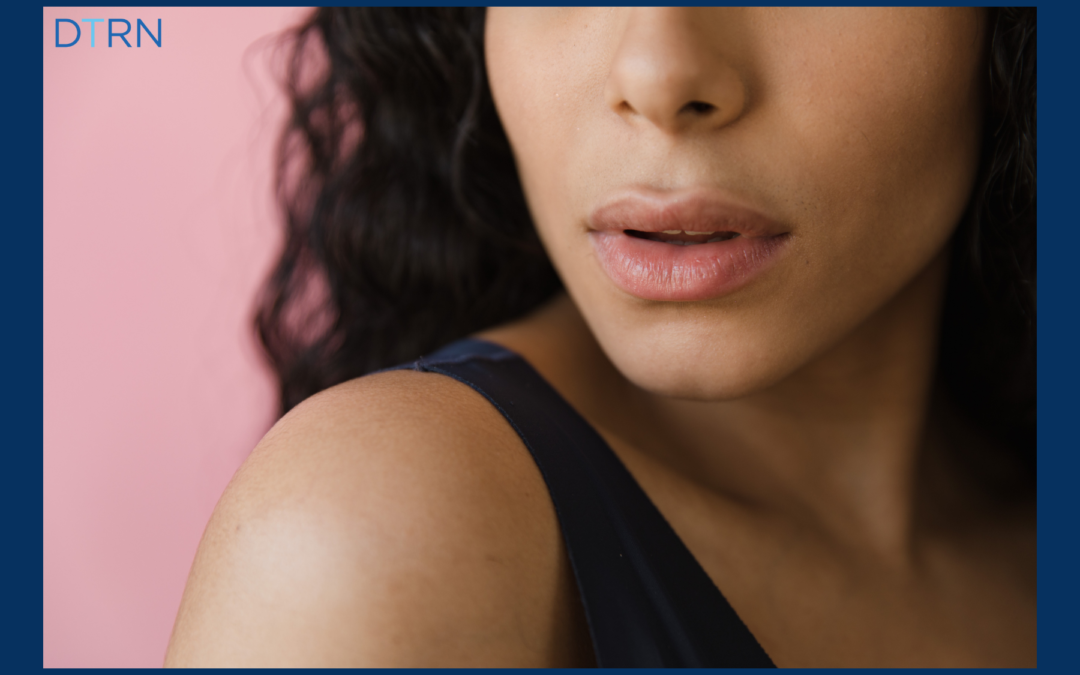Ready for a lip filler treatment? This post will help you know what to expect and ensure you implement the best Lip Filler aftercare…
If you are reading this blog, you likely are considering lip fillers for lip augmentation. Perhaps you are doing your homework in order to care for new fillers or to be prepared when you do go for it!
Lip fillers give your lips a plumper pout and a fuller appearance. Currently there are four FDA approved dermal fillers types. They include:
- hyaluronic acid
- calcium hydroxylapatite
- PLLA or poly-L-lactic acid
- PMMA or polymethylmethacrylate beads suspended in bovine (cow) collagen
If you haven’t already dipped your toe (or in this case lips) into the dermal lip filler world, you’ll be happy to know that the procedure can be done on your lunch hour. The minimally invasive lip filler injections take only a few minutes. Because most lip fillers are not permanent, you will have time to see (literally) if you like the look of your fuller lips and how they enhance your beauty before scheduling future injections to maintain them.
Though you may experience minor tenderness and swelling after the injections, lip filler aftercare is a walk in the park. Read on to discover the manageable aftercare protocol.
How do lip fillers work?
Dermal fillers are injected directly into the skin to plump and add volume to the lips. You’ll see instant results with little to no downtime.
What are the different types of lip fillers?
Lip Fillers are an excellent and available non-invasive aesthetic treatment to enhance your lips. There are four primary FDA approved dermal fillers available for cosmetic aesthetic use. They are :
- calcium hydroxylapatite
- poly-L-lactic acid (PLLA)
- polymethylmethacrylate beads suspended in bovine (cow) collagen (PMMA)
- hyaluronic acid
Radiesse Lip filler is an example of a long lasting Calcium Hydroxyapatite filler. It lasts about a year. Poly-L-lactic acid (PLLA) is the active ingredient in Sculptra dermal fillers. Sculptra requires multiple treatments and can last up to 2 years. PMMA (polymethyl-methacrylate microspheres) is a semi-permanent dermal filler and can be used to augment thin lips.
Juvederm lip fillers use Hyaluronic acid to create natural looking aesthetic augmentation particularly for your lips. The Juvederm family of dermal fillers is the most popular filler on the market. Because hyaluronic acid filler is not permanent, you and your aesthetic professional can literally choose the optimal plumpness for your lips. If you do not like what you see after your treatment, the effect will go away over time or if necessary you can have the treatment “dissolved” with an enzyme injection. Juvederm hyaluronic lip fillers give you the freedom to get the optimal natural looking pout.
10 Aftercare Tips for Lip Fillers
- Check with your lip filler treatment provider as to the best options for your specific treatment.
- Arnica cream can be applied to the treatment are if you have bruising or swelling.
- Immediately following your treatment, apply ice wrapped in a wash cloth or an ice pack to the treatment area to help ease bruising, swelling, and pain.
- Drink plenty of water to remain hydrated and support your body’s healing process.
- Avoid activities that can make swelling worse, like using saunas, doing hot yoga, and being in steam rooms, for up to 48 hours following treatment.
- Light exercise is generally ok, though strenuous exercise that increases your heart rate and blood pressure can make bruising and swelling more pronounced. Such exercise should be avoided for 24 to 48 hours after treatment.
- Don’t use makeup, like lipstick or foundation, in your lip area for up to 24 hours after treatment.
- Avoid foods that might increase swelling, like foods high in sodium.
- Ask your doctor what medications are ok to use following your procedure. Medications that act as blood thinners, such as aspirin, should typically be avoided.
- It can take up to two weeks for your lip filler treatment to settle, so be patient and allow up to two weeks to see the “final” results. This is also why it’s important to get fillers at least a couple of weeks before a special event.
Things to Avoid During Your Lip Filler Aftercare
In order to get the best results possible from your Lip Fillers, here is an important tip about what to avoid as you care for your lovely new lips. You likely will want to celebrate your new plumper pout but please choose sparkling water during the first day after receiving lip filler treatment. In other words, avoid alcohol for the first 24 hours. Why? Alcohol can cause inflammation and thin the blood thus increasing your bruising and/or swelling.
Possible Lip Augmentation Side Effects
As with any procedure, there are possible side effects with Lip Filler treatments. Side effects with lip filler treatment are mild and typically occur very soon after treatment, showing up within the first few hours or sometimes a few days after treatment.
Side effects that you may expect with Lip Filler treatment are light bruising, swelling and tenderness, some redness and possible itching or rash. These issues typically resolve quickly; within a short time span of a few days to a week, according to the Food and Drug Administration (FDA).
On rare occasions, individuals may have more serious or complicated side effects. If you experience intense swelling or bruising that lasts for longer than a week after treatment, contact your provider. These more serious side effects are considered unusual and even rare, but it is a possibility that allergies and complex reactions can occur.
Additional side effects to look for after Lip Filler treatment include lumping at the point of injection. Most lumping, if it occurs at all, will “dissolve” and improve with gentle massage and the passage of time. There are, however, successful treatment options for nodules that occur with lip filler treatment and can be administered according to the type of lip filler treatment you received.
Be sure to inform your doctor if you are prone to cold sore or herpes simplex virus 1 (HSV-1) outbreaks. On occasion, an outbreak can be triggered by dermal lip fillers. If you’ve read this far, good for you for doing your homework and gaining an understanding of lip filler treatment pros and cons.
DermaTouch RN can guide you during your lip filler aftercare
Book your San Antonio or Houston appointment or consultation online 24/7. Or, call 210.951.3520 (San Antonio) or 281.895.9090 (Houston) to schedule! Also, ask about our DermaTouch RN monthly specials to see how much you can save on your lip augmentation treatment.
DermaTouch RN offers minimally invasive and non-invasive treatments for men and women in Houston, San Antonio, Spring and Cypress, as well as the surrounding areas of Texas. We are the largest aesthetic practice in the Houston area, and all of our medical spa treatments are performed by a team of nurse practitioners, registered nurses, and aestheticians who receive continuing education to remain abreast of emerging treatments that benefit our patients. We invite you to learn more about our office before your consultation.





